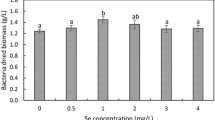Abstract
The bioavailability of selenium (Se) was determined in bacterial strains that reduce selenite to red elemental Se (Seo). A laboratory strain ofBacillus subtilis and a bacterial rod isolated from soil in the vicinity of the Kesterson Reservoir, San Joaquin Valley, CA, (Microbacterium arborescens) were cultured in the presence of 1 mM sodium selenite (Na2SeO3). After harvest, the washed, lyophilizedB. subtilis andM. arborescens samples contained 2.62 and 4.23% total Se, respectively, which was shown to consist, within error, entirely of Seo. These preparations were fed to chicks as supplements to a low-Se, vitamin E-free diet. Three experiments showed that the Se in both bacteria had bioavailabilities of approx 2% that of selenite. A fourth experiment revealed that gray Seo had a bioavailability of 2% of selenite, but that the bioavailability of red Seo depended on the way it was prepared (by reduction of selenite). When glutathione was the reductant, bioavailability resembled that of gray Seo and bacterial Se; when ascorbate was the reductant, bioavailability was twice that level (3–4%). These findings suggest that aerobic bacteria such asB. subtilis andM. arborescens may be useful for the bioremediation of Se-contaminated sites, i.e., by converting selenite to a form of Se with very low bioavailability.
Similar content being viewed by others
References
S. McCarty, T. Chasteen, M. Marshall, R. Fall, and R. Bachofen, Phototrophic bacteria produce volatile methylated sulfur and selenium compounds,FEMS Microbiol. Lett. 112, 93–97 (1993).
D. R. Lovley, Dissimilatory metal reduction,Ann. Rev. Microbiol. 67, 263–290 (1993).
A. O. Summers and S. Silver, Microbial transformation of metals,Ann. Rev. Microbiol. 32, 637–672 (1978).
B. B. Buchanan, T. Leighton, J. Liu, B. C. Yee, S. Jovanovich, A. Yee, W.-S. Yang, S. Ekune, and B. Chapman, Bioremediation of selenium using the bacteriumBacillus subtilis. Abstracts of Fifth International Symposium on Selenium in Biology and Medicine, Vanderbilt Univ. School of Med., Nashville, TN, p. 30 (1992).
B. B. Buchanan, J. J. Bucher, D. E. Carlson, N. M. Edelstein, E. A. Hudson, N. Kaltsoyannis, T. Leighton, W. Lukens, H. Nitsche, T. Reich, K. Roberts, D. K. Shuh, P. Torretto, J. Woicik, W.-S. Yang, A. Yee and B. C. Yee, A XANES and EXAFS investigation of the speciation of selenite following bacterial metabolization,Inorg. Chem. In press.
C. Garbisu, S. Gonzalez, W.-H. Yang, B. C. Yee, D. E. Carlson, A. Yee, N. R. Smith, R. Otero, B. B. Buchanan, and T. Leighton, Physiological mechanisms regulating the conversion of selenite to elemental selenium byBacillus subtilis, BioFactors. In press.
K. Schwarz and C. M. Foltz, Factor 3 activity of selenium compounds,J. Biol. Chem. 233, 245–254 (1958).
A. H. Cantor, M. L. Scott, and T. Noguchi, Biologic availability of selenium in feedstuffs and selenium compounds for prevention of exudative diathesis in chicks,J. Nutr. 105, 96–107 (1975).
M. J. Axley and T. C. Stadtman, Selenium metabolism and selenium-dependent enzymes in microorganisms,Ann. Rev. Nutr. 9, 127–137 (1989).
T. Schrader and J. R. Andreesen, Purification and characterization of protein-P(C), a component of glycine reductase fromEubacterium acidaminophilum, Eur. J. Biochem. 206, 1–13 (1992).
J. B. Jones and T. C. Stadtman, Selenium-dependent and selenium-independent formate dehydrogenases ofMethanoccoccus vannielii. Separation of the two forms and characterization of the purified selenium-independent form,J. Biol. Chem. 256, 656 (1981).
T. C. Stadtman, Specific occurrence of selenium in certain enzymes and amino acid transfer ribonucleic acids,Phosphorus Sulfur 24, 199–211 (1985).
G. F. Combs, Jr., The selenium needs of laying and breeding hens,Poultry Sci. 58, 871–884 (1979).
G. F. Combs, Jr., Influence of ethoxyquin on the utilization of selenium by the chick,Poultry Sci. 57, 210–222 (1978).
B. R. Bochner, Sleuthing out bacterial identities,Nature 339, 157, 158 (1989).
L. M. McShane, L. C. Clark, G. F. Combs, Jr., and B. W. Turnbull, Reporting the accuracy of biochemical measurements for epidemiologic and nutrition studies,Am. J. Clin. Nutr. 53, 1354–1360 (1991).
O. E. Olson, I. S. Palmer, and E. E. Cary, Modification of the official method for selenium in plants,J. Assoc. Off. Anal. Chem. 58, 117–121 (1975).
D. E. Paglia and W. N. Valentine, Studies on the quantitative and qualitative characterization of erythrocyte glutathione peroxidase,J. Lab. Clin. Med. 70, 158–169 (1967).
R. A. Lawrence, and R. F. Burk, Glutathione peroxidase activity in selenium-deficient rat liver,Biochem. Biophys. Res. Commun. 71, 952–958 (1976).
G. F. Combs, Jr. and S. B. Combs, The biologic availability of selenium in foods and feeds, inThe Role of Selenium in Nutrition, Academic, New York, pp. 127–178 (1986).
G. F. Combs, Jr. and S. B. Combs, Selenium in foods and feeds, inThe Role of Selenium in Nutrition, Academic, New York, pp. 41–126 (1986).
G. F. Combs, Jr. and G. M. Pesti, Influence of ascorbic acid on the selenium nutrition of the chick,J. Nutr. 106, 958–966 (1976).
M. S. Cupp, G. F. Combs, Jr., and R. A. Corradino, Ascorbate interacts with selenium to increase glutathione peroxidase activity in selenium-deficient chick duodena cultured in vitro,Biol. Trace Elem. Res. 20, 87–94 (1988).
Author information
Authors and Affiliations
Rights and permissions
About this article
Cite this article
Combs, G.F., Garbisu, C., Yee, B.C. et al. Bioavailability of selenium accumulated by selenite-reducing bacteria. Biol Trace Elem Res 52, 209–225 (1996). https://doi.org/10.1007/BF02789163
Received:
Accepted:
Issue Date:
DOI: https://doi.org/10.1007/BF02789163




